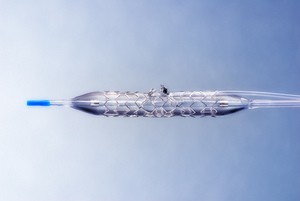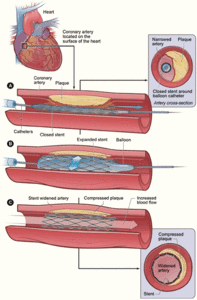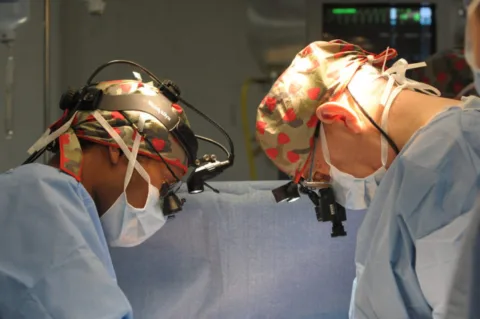I had a coronary artery stent put in several years ago.
I was experiencing an unusual pressure in my jaw along with a few other symptoms, so I had it checked out.
After a series of tests, I was told that I needed to have a heart stent put in immediately.
You may be wondering:
- What is a coronary artery stent?
- How does it work?
- How would you know if you needed a coronary artery stent?
- What’s the difference between an angiogram and angioplasty?
- Does your lifestyle need to change after having a heart stent put in?
Following are the answers to those questions, as well as my own personal experience with having a heart stent put in…
 What Is A Coronary Artery Stent?
What Is A Coronary Artery Stent?
According to the American Heart Association:
A stent is a wire metal mesh tube used to prop open an artery during angioplasty. The stent is collapsed to a small diameter and put over a balloon catheter. It’s then moved into the area of the blockage. When the balloon is inflated, the stent expands, locks in place and forms a scaffold. This holds the artery open. The stent stays in the artery permanently, holds it open, improves blood flow to the heart muscle and relieves symptoms (usually chest pain). Within a few weeks of the time the stent was placed, the inside lining of the artery (the endothelium) grows over the metal surface of the stent. Source
Compare this to balloon angioplasty — a means of opening up blocked arteries that dates back to 1977. With balloon angioplasty, a deflated balloon is inserted into the blocked artery, inflated for 30 to 60 seconds, then removed. Often, however, the blockage would return.
A deflated balloon is mounted over a skinny catheter and delivered to the coronary artery blockage over a flexible guide wire. The balloon was inflated for about 30 to 60 seconds to open up the blocked passage. However, it suffered from a disadvantage. Although the results looked very good immediately after deflation and removal of the balloon catheter, the blockage would partially return, similar to a sponge becoming larger after being squeezed. This is known as “recoil.” Recoil causes the channel to become smaller after having been enlarged by balloon expansion. In other words, a 90% blockage may improve to 20% immediately after PTCA. However, recoil may cause the blockage to worsen and become 30-50% in severity within 15-30 minutes. Source
In 1993, the coronary artery stent that is commonly used today was invented. Their longterm success — in terms of preventing arteries from becoming blocked — again has been significant.
Coronary stents were introduced to combat “recoil.” A stent is a stainless tube with slots. It is mounted on a balloon catheter in a “crimped” or collapsed state. When the balloon is inflated, the stent expands or opens up and pushes itself against the coronary artery blockage. This holds the artery open after the balloon is deflated and removed. Stents behave like a cage that holds the expanded material in place and markedly reduces the amount of recoil. Source
These days, coronary stent procedures are very common. Some say they are too common.
How Do You Know When You Need A Heart Stent?
If you’re experiencing symptoms that are commonly associated with a heart attack, you may have coronary artery disease.
A heart stent can help to alleviate those symptoms.
The most common symptoms of coronary heart disease include:
- Chest pain
- Shortness of breath when exercising or during vigorous activity
- A fast heartbeat
- Weakness, dizziness, and nausea
- Increased sweating
The coronary arteries provide blood to the heart muscle. They are, in essence, pipes conveying oxygenated blood to the heart muscle. These arteries can have partial blockage from cholesterol plaques obstructing blood flow. When the muscle doesn’t get enough oxygen, it can cause chest pain. In extreme cases it can cause a myocardial infarction or heart attack, which means some of the heart muscle dies. Source
How I Found Out I Needed A Coronary Artery Stent
I had pressure under my jaw and my hand moved as if it had commands from another brain.
I went to the emergency room and they kept me. The doctors ran several tests on me including an electrocardiogram.
My primary care doctor saw a small anomaly on the readout of the electrocardiogram. She sent me to have an MRI on a machine especially made to examine the heart.
- The technicians first ran a series of pictures of my heart beating regularly.
- Then, a nurse injected a medicine that stressed my heart. That was not pleasant. But it didn’t last long.
- After that, the technicians ran another series of pictures.
Several days later, my cardiologist called me to tell me that one of my coronary arteries was 75% blocked. He scheduled me for an angiogram and an angioplasty.
These videos show how the 2 procedures are done:
What It Was Like Having A Coronary Artery Stent Put In
I couldn’t eat or drink anything for 8 hours before my angiogram.
My surgeon did the angiogram to pinpoint where he needed to place the coronary artery stent.
Here’s how it went:
 In the hospital, I was taken to a catheterization lab.
In the hospital, I was taken to a catheterization lab.- The catheterization team prepped me for the angiogram. A Registered Nurse (RN) swabbed down the inside of my right thigh with an antiseptic.
- The team injected that area of my thigh with a local anesthesia. The injections were the only pain I felt. I was also receiving a mild sedative through an IV. I didn’t feel anything when the doctor made an incision, inserted the catheter, and injected the dye.
- After the angiogram was completed, I was taken to the post-operative area.
- A nurse gave me several pills of a blood thinning medication. It was important to prevent blood clots. She also gave me a sandwich, my first food of the day.
- An RN came in and took out the sheath that had been inserted as a guide for the catheter. She then put pressure on the incision. (The surgeon had cut an artery to insert the catheter. It was extremely important to apply pressure to that wound. Otherwise, I could bleed to death.) I don’t remember exactly how long she held that pressure, but it was a long time. I wondered how she was able to do that for so long.
- When she stopped applying pressure, she put a bandage on the incision. I had to lie flat on my back for several hours, in order to not put pressure on the incision. The nurse gave me pain medication because lying on my back for so long was painful.
- I went home because they had had several emergency angioplasties and ran out of time to do mine. When I went back to have the stent put in (angioplasty), it was just like having the angiogram. This time, however, the surgeon put in the stent. At the end, when the bandage was put on, I ate lunch flat on my back in a regular hospital room.
- Generally speaking, an angioplasty doesn’t hurt. Numbing the incision area on my inner thigh was the only pain I felt.
- As far as changing your lifestyle after the coronary artery stent is in, you have to participate in cardiac rehabilitation, change your diet, and possibly take medication. These are all parts of keeping your heart healthy.
Are There Any Downsides To Having A Heart Stent?
All medical procedures come with some risks.
During the coronary artery stent procedure, there are several things that could possibly go wrong during or after the heart catheterization, including:
- Allergic reaction to the x-ray dye
- Bleeding or clotting in the area where the catheter was inserted
- Damage to a heart valve or blood vessel
- Heart attack
- Kidney failure (a higher risk in people who already have kidney problems)
- Irregular heartbeats (arrhythmias)
- Stroke (this is rare)
- Allergic reaction to the stent material
- Drug-coated stents (also known as drug-eluting stents) have their own side effects
- Blood clot
- Clogging of the inside of the stent (in-stent restenosis)
Alternatives To Angioplasty & Having A Heart Stent Put In
There are some alternatives to having a coronary artery stent put in. For example, medication can dilate the blood vessels in the heart. However, medication can’t make the blockages in your arteries go away.
Alternatives to angioplasty include heart medications and coronary artery bypass surgery (also known as open heart surgery). Medication can dilate the blood vessels in the heart, but it can’t make blockages go away. Bypass surgery requires general anesthesia, and it involves replacing a damaged artery in your heart with a healthy blood vessel or a man-made graft. The goal of these alternatives is to increase blood flow to the heart. Source




